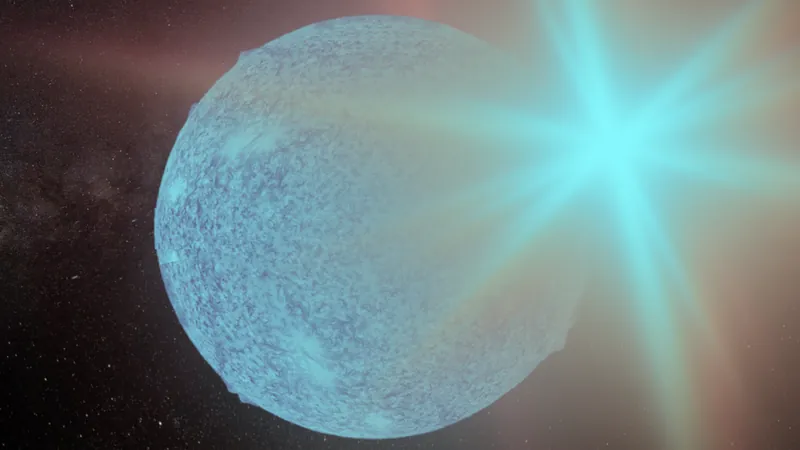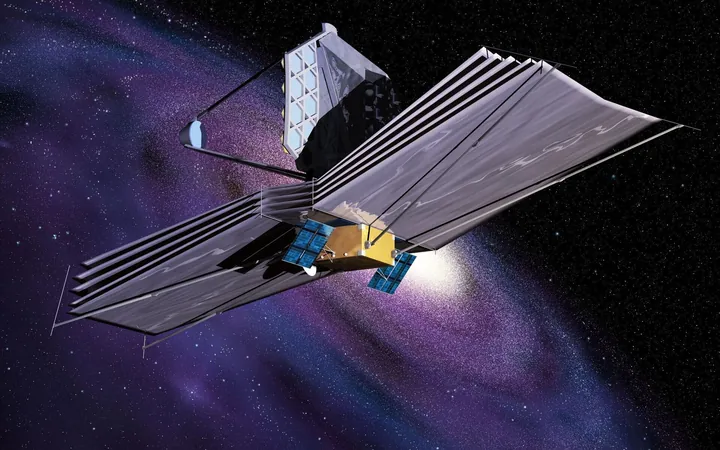
Astounding Discovery: Dead Star Spins 716 Times a Second and Unleashes Explosions Rivalling Atomic Bombs!
2024-11-05
Author: Benjamin
Introduction
Astronomers have made a groundbreaking discovery in the cosmos—a neutron star spinning at a jaw-dropping rate of 716 times per second, making it the joint fastest-spinning cosmic body ever observed! This extraordinary star isn’t merely a rapid rotator; it is also experiencing violent eruptions akin to the detonation of atomic bombs.
Observation Methodology
Utilizing NASA's Neutron star Interior Composition Explorer (NICER), which is brilliantly situated on the exterior of the International Space Station (ISS), the research team investigated the remnants of stellar evolution in the binary system known as 4U 1820-30. This system resides within the globular cluster NGC 6624, located around 26,000 light-years from Earth in the majestic constellation of Sagittarius.
Team Insights
Team member Gaurava K. Jaisawal from DTU Space revealed, "While studying the thermonuclear explosions from the system, we detected remarkable oscillations indicating how rapidly the neutron star is spinning around its axis at an astonishing 716 times per second."
Binary System Characteristics
This record-setting neutron star shares its binary system with a white dwarf, another cosmic remnant formed from stars with masses similar to our sun. Notably, this white dwarf orbits its neutron star companion every 11 minutes, marking it as the binary star system with the shortest orbital period ever documented.
Formation of Neutron Stars
Neutron stars, like the one in 4U 1820-30, are born from the catastrophic deaths of massive stars that exceed eight times the mass of our sun. The process of stellar death leads to extreme characteristics in neutron stars, including rapid spin rates and fierce thermonuclear explosions.
What Makes Neutron Stars So Unique?
When a massive star exhausts its nuclear fuel, it loses the radiation pressure that holds it against the force of gravity. Subsequently, its core collapses under immense gravitational pressure, resulting in a supernova that expels much of the star’s outer layers. The remnant core then transforms into a neutron star, a dense stellar object typically 1 to 2 times the mass of the sun but shrinking to a mere diameter of around 12 miles (20 kilometers).
The conservation of angular momentum explains the rapid spin of neutron stars. Analogy: like an ice skater who increases their spin speed by pulling their arms close to their body, neutron stars spin faster as they collapse. Additionally, in tight binary systems, neutron stars can siphon matter from their companion, boosting their rotation speed and leading to explosive thermonuclear reactions.
To illustrate the astonishing density of neutron stars: if just a teaspoon of neutron star material were transported to Earth, it would weigh approximately 10 million tons—equivalent to about 85,000 blue whales!
Energy Release and Impacts
This extreme density results in a powerful gravitational pull. Matter that approaches a neutron star is accelerated to astounding velocities, and upon impact with the stellar surface, it triggers an immense energy release. For context, if a common marshmallow fell onto a neutron star, its impact would unleash energy comparable to that of 1,000 hydrogen bombs detonation simultaneously!
Thermonuclear Explosions
When sufficient stellar material accumulates on a neutron star's surface, it can reach a critical mass, igniting a cataclysmic thermonuclear explosion. During these extraordinary bursts, the neutron star can shine up to 100,000 times brighter than our sun, unleashing tremendous energy, as highlighted by team scientist Jerome Chenevez. "We are observing extreme events, and through their detailed study, we gain invaluable insights into the life cycles of binary star systems and the universe's element formation."
NICER Observations
NICER meticulously observed the binary system 4U 1820-30 between 2017 and 2021, during which the DTU Space team identified 15 thermonuclear blasts, captured through the X-ray light these explosions emitted.
Conclusion
One such explosion exhibited a phenomenon known as "thermonuclear burst oscillations," with a frequency of 716 Hz. This oscillation, synchronized with the neutron star's spin rate, confirms it is indeed rotating 716 times a second. Jaisawal added, "If future observations verify this, the 4U 1820-30 neutron star would stand among the fastest-spinning objects ever recorded in the universe, alongside another neutron star, PSR J1748-2446." This striking discovery not only highlights the marvels of stellar physics but also beckons further explorations into the mysterious lives of stars and their remnants scattered throughout our universe.









 Brasil (PT)
Brasil (PT)
 Canada (EN)
Canada (EN)
 Chile (ES)
Chile (ES)
 España (ES)
España (ES)
 France (FR)
France (FR)
 Hong Kong (EN)
Hong Kong (EN)
 Italia (IT)
Italia (IT)
 日本 (JA)
日本 (JA)
 Magyarország (HU)
Magyarország (HU)
 Norge (NO)
Norge (NO)
 Polska (PL)
Polska (PL)
 Schweiz (DE)
Schweiz (DE)
 Singapore (EN)
Singapore (EN)
 Sverige (SV)
Sverige (SV)
 Suomi (FI)
Suomi (FI)
 Türkiye (TR)
Türkiye (TR)